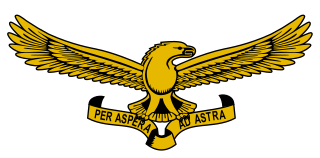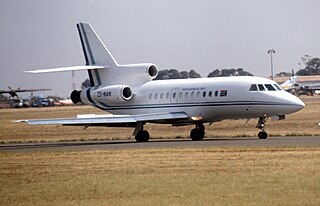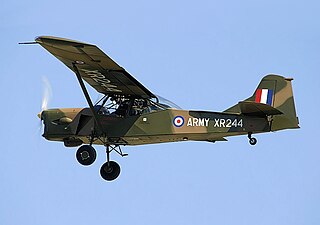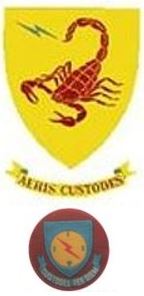
The South African Air Force (SAAF) is the air warfare branch of South African National Defence Force, with its headquarters in Pretoria. The South African Air Force was established on 1 February 1920. The Air Force saw service in World War II and the Korean War. From 1966, the SAAF was involved in providing infantry support in the low-intensity Border War in Angola, South-West Africa and Rhodesia. As the war progressed, the intensity of air operations increased, until in the late 1980s when the SAAF were compelled to fly fighter missions against Angolan aircraft in order to maintain tactical air superiority. On conclusion of the Border War in 1990, aircraft numbers were severely reduced due to economic pressures as well as the cessation of hostilities with neighbouring states.

The Atlas Cheetah is a South African fighter aircraft designed and produced by the aviation company Atlas Aircraft Corporation. It was developed at the behest of, and principally operated by, the South African Air Force (SAAF).

2 Squadron is a squadron in the South African Air Force which was formed in 1940. The squadron has a long history, having been involved in every single combat action in which the SAAF has taken part. During the Second World War it made a name for itself in the battles for East Africa, before distinguishing itself in North Africa as part of the Desert Air Force, and later in Italy.

19 Squadron SAAF is a current squadron of the South African Air Force operating as a transport/utility helicopter squadron. It was formed in 1939 as part of the Air Force airways Wing, flying transport aircraft but was disbanded after a few months. It was re-formed from No. 227 Squadron RAF in 1944 and disbanded again after the end of World War II. It was again re-established in 1970 as a helicopter squadron – a role which it still performs today.

21 Squadron SAAF is a squadron of the South African Air Force. It was formed as a bomber squadron in Kenya during World War II and became a VIP transport squadron in the 1960s, a role which it performs to this day. The squadron currently flies two Dassault Falcon 50s, two Cessna Citation Is, a Dassault Falcon 900 and a Boeing BBJ aircraft. 21 Squadron is one of the most active squadrons in the air force with 606 VIP transport flights being made between 2009 and 2012. The Boeing BBJ is used as the presidential aircraft when the President of South Africa travels and designated callsign LMG1.

41 Squadron is a light transport squadron of the South African Air Force. It was formed in 1940, it is currently based at AFB Waterkloof.

60 Squadron SAAF is a squadron of the South African Air Force. It is a transport, aerial refuelling and EW(electronic warfare)/ELINT(electronic intelligence) squadron. It was first formed at Nairobi in December 1940.

The Aermacchi AM.3 was the result of a joint venture between Aermacchi and Aeritalia in response to an Italian Army requirement for an aircraft to replace the Cessna L-19, and was initially designated the MB-335.
Operation Protea was a military operation during the South African Border War and Angolan Civil War in which South African Defence Forces (SADF) destroyed a number of South West Africa People's Organisation (SWAPO) bases in Angola. During the operation, which took place from 23 August to 4 September 1981, up to 5,000 SADF soldiers occupied Cunene province, Angola.

The Taylorcraft Auster was a British military liaison and observation aircraft produced by the Taylorcraft Aeroplanes (England) Limited company during the Second World War.

The Auster AOP.9 was a British military air observation aircraft produced by Auster Aircraft Limited to replace the Auster AOP.6.
The South African Air Force Museum houses exhibits and restores material related to the history of the South African Air Force. The museum is divided into three locations, AFB Swartkop outside Pretoria, AFB Ysterplaat in Cape Town and at the Port Elizabeth airport.

Air Force Base Swartkop is South Africa's oldest air force base and houses the South African Air Force Museum. It is managed as part of AFB Waterkloof and houses one of the three branches of the South African Air Force Museum. The name of the air force base, Swartkop means Black hill in Afrikaans.

AFB Durban is an airbase of the South African Air Force, located in Durban, KwaZulu-Natal, South Africa. The runway is shared with the Durban International Airport. The airbase is at the northern end of the runway.

An air observation post (AOP) is an aeroplane or helicopter used in the role of artillery spotter by the British Army and Commonwealth forces. In this role, either the pilot of the aircraft or another crew member acts as an observer watching for targets on the ground, and/or as a forward observation officer directing the fire, by radio, of artillery on the ground.

11 Squadron was a World War II squadron of the South African Air Force. It was created in South Africa in 1939 and served in East Africa until 1941 as an army cooperation and reconnaissance squadron. It was re-formed in 1944 as a fighter bomber squadron and served in Italy until 1945 when it returned to Egypt and was disbanded on conclusion of the war on 30 October 1945. It was re-activated in 1974, flying Cessna 185s as an army liaison squadron until 1991 when it disbanded for the final time.

8 Squadron was a South African Air Force squadron during World War II and was again active between 1951 and 2001. During this second period, it was designated at different times as either a Citizen Force or Permanent Force squadron and was disbanded on 31 March 2001.
The History of the South African Air Force spans the First World War, Rand Rebellion of 1922, the Second World War, the Korean War, the South African Border War, and varied peacekeeping operations since 1994. Its battle honours include German South West Africa 1914–15, German East Africa 1915–1918, East Africa: 1939–1941, Middle East: 1941–43, Madagascar 1942, Italy 1943–1945, the Balkans 1943–1945, and Korea 1950–1953.

89 Combat Flying School is a disbanded unit of the South African Air Force, active from 1986-1992. The unit was formed on 1 July 1986 from the Mirage Flight of 85 Combat Flying School at AFB Pietersburg and its main role was to train aircrew to fly the Dassault Mirage aircraft.

121 Squadron SAAF was a South African Air Force squadron formed in 1974 to operate the British Tigercat surface-to-air missile systems in an air defence role. The unit was disbanded when the Tigercat system was retired from service in the early 1990s.
























